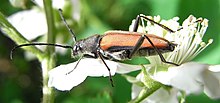Black-lined narrow buck
| Black-lined narrow buck | ||||||||||||
|---|---|---|---|---|---|---|---|---|---|---|---|---|

Black-lined Cinderella ♂ on blackberry blossom |
||||||||||||
| Systematics | ||||||||||||
|
||||||||||||
| Scientific name | ||||||||||||
| Anastrangalia dubia | ||||||||||||
| ( Scopoli , 1763) |
The Schwarzgesaumte Schmalbock or Schwarzrandiger Schmalbock ( Anastrangalia dubia outdated, Leptura dubia ) is a beetle from the family of the longhorn beetle and the subfamily Lepturinae . It is one of the many similar small longhorn beetles that were previously grouped together in the genus Leptura . The individual specimens vary greatly in their appearance.
The species is listed in the Red Lists of the states of Saxony-Anhalt and Thuringia as extinct or missing, and in the state of Saxony as endangered.
Comments on the name and the system
The name part "Schmalbock" shows the affiliation of the way of the narrow blocks on which part of the name "schwarzgesaumt" or refers "schwarzrandig" on the black outer edge of the wing cases in males. The species name dubia (from Latin dūbius, dubious) alludes to the fact that its position was not certain when it was first described. The species was first described by Scopoli in 1763 and placed as Leptura dubia in the genus Leptura . Scopoli writes behind the diagnosis of the species: In vere diverse a priore? an proles hybrida Melanurae & Vexillatae? (Latin. Does it really differ from the preceding (species)? Or is it a cross of melanura and vexillata ?). The genus Anastrangalia ( give a wiki. Άνα- ana = reinforcing, adventitious to the genus Strangalia ) was only in 1924 by Casey as new subgenus of the genus Strangalia attached. Casey characterizes Anastrangalia as standing between Strangalia and Brachyleptura . In the standard work Freude-Harde Lohse, the name is not changed from Leptura dubia to Anastrangalia dubia until the third supplementary volume . The genus Anastrangalia comprises four species in Europe and thirteen species worldwide.
Characteristics of the beetle
The beetle reaches a length of nine to 16 millimeters. The body and antennae are all black.
The pronotum is narrow, not hunched at the sides. It is clearly pinched behind the front edge. The rear corners are rounded, not pointed.
The elytra are yellow-brown in the male with a more or less wide black side stripe. The tip of the wing covers and the wing cover seam are also black. In the female, the elytra are red with a black tip and side margin. Completely black specimens are more common in the females, and very rarely in the males. The elytra are fine and evenly punctured. They are hairy yellow and dull, in males they can also be shiny.
The temples are long and widened like a cheek. The bell-shaped pronotum is constricted at the front edge and is significantly longer than it is wide. In the rear part it has a flat longitudinal furrow in the middle.
biology
The adults appear in Central Europe from June to August. The montane to subalpine species can be found on blossoms as well as on wood, most often on clear-cuts with rich herbal flora. Among the flowers, umbellifers are mainly flown to; among the woods, felled trunks and wooden fathers from spruce , fir and pine are preferred.
The larva develops in conifers (spruce, fir and pine). It takes two to three years to develop. The adult beetle appears from June to August.
distribution
The species is widespread not only in Europe, but also in parts of North Africa, as well as in the Caucasus and northern Iran.
Individual evidence
- ↑ a b Anastrangalia dubia at Fauna Europaea. Retrieved December 20, 2010
- ↑ Red lists at Science4you
- ↑ Sigmund Schenkling: Explanation of the scientific beetle names (species)
- ↑ JA Scopoli: Entomologia Carniolica exhibens insecta Carnioliæ indigena et distributa in ordines, genera, species, varietates. Methodo Linnæana Vindobonae 1763 Original description on page 47 as No. 151 in Google e-Book
- ↑ Thos. L. Casey 1924 in Memoirs on the Coleoptera Vol. 11 p. 280 at BHL
- ^ Gustav Adolf Lohse, Wilhelm H.Lucht: Die Käfer Mitteleuropas . 3. Supplementary volume with catalog section. Goecke & Evers, Krefeld 1994, ISBN 3-87263-045-8 .
- ↑ Anastrangalia at Fauna Europaea. Retrieved February 19, 2013
- ↑ Anastrangalia at BioLib
literature
- Heinz joy, Karl Wilhelm Harde, Gustav Adolf Lohse (ed.): The beetles of Central Europe . tape 9 . Cerambycidae Chrysomelidae . Spektrum Akademischer Verlag, Munich 1999, ISBN 3-8274-0683-8 (first edition: Goecke & Evers, Krefeld 1966).
- Wilhelm H. Lucht, Bernhard Klausnitzer: The beetles of Central Europe . Ed .: Heinz Freude (= Käfer Mitteleuropas . Volume 15 ; 4th supplement band). Gustav Fischer / Goecke & Evers, Jena / Krefeld 1998, ISBN 3-437-35366-7 .
- Klaus Koch : The Beetles of Central Europe . Ed .: Heinz Freude . tape 3 : ecology . Goecke & Evers, Krefeld 1992, ISBN 3-87263-042-3 .
- Adolf Horion : Faunistics of the Central European Beetles, Bd. XII . Überlingen-Bodensee 1974
